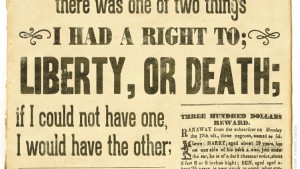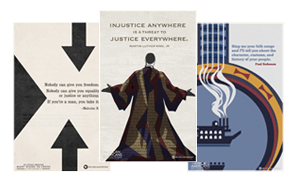Who Really Ran the Underground Railroad?
One of the genuine pleasures of teaching African-American Studies today is the satisfaction of being able to restore to the historical record “lost” events and the individuals whose sacrifices and bravery created those events, never to be lost again. Few institutions from the black past have attracted more attention recently from teachers, students, museum curators and the tourism industry than the Underground Railroad, one of the most venerable and philanthropic innovations in our ancestors’ long and dreadful history in human bondage. But in the zeal to tell the story of this great institution, legend and lore have sometimes overwhelmed historical facts. Separating fact from fiction — always an essential part of telling it like it really was — has required a great deal of effort from a number of scholars. Doing so only makes the sacrifices and heroism of our ancestors and their allies all the more noble, heroic and impressive.
Sometimes when I hear our students talk about the Underground Railroad, it seems to me that they are under the impression that it was akin to a black, Southern Grand Central Station, with regularly scheduled routes that hundreds of thousands of slave “passengers” used to escape from Southern plantations, aided by that irrepressible, stealthy double agent, Harriet Tubman. Many also seem to believe that thousands of benign, incognito white “conductors” routinely hid the slaves in secret rooms concealed in attics or basements, or behind the staircases of numerous “safe houses,” the locations of which were coded in “freedom quilts” sewn by the slaves and hung in their windows as guideposts for fugitives on the run.
The “railroad” itself, according to this legend, was composed of “a chain of stations leading from the Southern states to Canada,” as Wilbur H. Siebert put it in his massive pioneering (and often wildly romantic) study, The Underground Railroad (1898), or “a series of hundreds of interlocking ‘lines,’ ” that ran from Alabama or Mississippi, throughout the South, all the way across the Ohio River and the Mason-Dixon Line, as the historian David Blight summarizes in Passages to Freedom: The Underground Railroad in History and Memory (a book, by the way, that should be required reading for all of us who want to understand the truth about the Underground Railroad and its important role in African-American history, as well as Fergus M. Bordewich’s Bound for Canaan: The Epic Story of the Underground Railroad, America’s First Civil Rights Movement). Fleeing slaves, often entire families, were allegedly guided at night in their desperate quest for freedom by the proverbial “Drinking Gourd,” the slave’s code name for the North Star.
The Railroad in Lore
A partial list of some of the most common myths about the Underground Railroad would include the following:
1. Well-intentioned white abolitionists, many of whom were Quakers, ran it.
2. The Underground Railroad operated throughout the South.
3. Most fugitive slaves who made it to the North found sanctuary along the way in secret rooms concealed in attics or cellars, and many escaped through tunnels.
4. Slaves created so-called “freedom quilts” and hung them at the windows of their homes to alert escaping fugitives to the location of safe houses and secure routes north to freedom.
5. The Underground Railroad was a large-scale activity that enabled hundreds of thousands of people to escape their bondage.
6. Entire families commonly escaped together.
7. The spiritual “Steal Away” was used to alert slaves that Harriet Tubman would be coming to town, or that an opportune time to flee was at hand.
Scholars such as Larry Gara in his book The Liberty Line: The Legend of the Underground Railroad and Blight, among others, have worked diligently to address all of these points, and I’ll summarize the correct answers based on their work, and that of others, at the end of this article. First, a short history of the Underground Railroad:
A Meme Is Born
The Railroad has proven to be one of the most “enduring and popular threads in the fabric of America’s national historical memory,” as Blight rightly puts it. Since the end of the 19th century, many Americans — especially in New England and the Midwest — have either fabricated stories about the exploits of their ancestors or simply repeated tales they have heard. However, before we tackle those tales, it’s worth looking at the origins of the term “Underground Railroad.”
Various explanations exist for how it was coined. Tice Davids was a Kentucky slave who successfully escaped to Ohio in 1831, and the term “Underground Railroad” may have been coined based on his escape. His owner had been pursuing Davids but lost track of him in Ohio. It is said he claimed that Davids disappeared as if “the nigger must have gone off on an underground railroad,” according to Blight. I love this story — an account worthy of Richard Pryor — but this seems unlikely, since rail lines barely existed at this time.
Two other possibilities exist. One story from 1839 claims that a fugitive slave from Washington, D.C., was tortured and confessed that he had been sent north, where “the railroad ran underground all the way to Boston.” If one checks the Liberator newspaper, however, the first time the term appears is on Oct. 11, 1839, in which an editorial by Hiram Wilson from Toronto called for the creation of “a great republican railroad … constructed from Mason and Dixon’s to the Canada line, upon which fugitives from slavery might come pouring into this province.”
The actual phrase “Underground Railroad” first appeared in the Liberator on Oct. 14, 1842, a date that may be buttressed by those who assert that the abolitionist Charles T. Torrey coined the phrase in 1842. In any event, as David Blight states, the phrase did not become common until the mid-1840s.
Myth Battles Counter-Myth
The appeal of romance and fancy in stories of the Underground Railroad can be traced to the latter decades of the 19th century, when the South was winning the battle of popular memory over the meaning of the Civil War — sending Lost Cause mythology deep into the national psyche and eventually helping to propel the Virginia-born racist Woodrow Wilson into the White House. In the face of a dominating Southern interpretation of the meaning of the Civil War, many white Northerners sought to preserve a heroic version of their past and found a useful tool in legends of the Underground Railroad.
Often well-meaning white people crafted “romantic adventure stories — about themselves,” as Blight puts it, stories that placed white “conductors” in heroic and romantic roles in the struggle for black freedom, stealing agency from supposedly helpless and nameless African Americans (who braved the real dangers), a counterpart to popular images of a saintly, erect Abraham Lincoln bequeathing freedom to passive, kneeling slaves. With the collapse of Reconstruction in 1876 — often blamed on supposedly ignorant or corrupt black people — the winning of freedom became a tale of noble, selfless white efforts on behalf of a downtrodden, faceless, nameless, “inferior” race.
Much of contemporary misunderstanding and myth about the Underground Railroad originated with Wilbur Siebert’s 1898 study. Siebert interviewed nearly everyone still living who had some memory related to the network and even traveled to Canada to interview former slaves who traced their own routes from the South to freedom.
While Siebert ignored the most fanciful stories he heard, he placed far too much emphasis on the work of so-called white conductors and depicted the experience as a very systematic and interrelated series of way stations and routes — which he traced in detailed maps — not unlike a railroad line or system of rail lines. As David Blight remarks, Siebert “fashioned a popular story of primarily white conductors helping nameless blacks to freedom.”
Truth Reveals Unheralded Heroism
That’s a bit of the history; what of those myths? Here are the answers:
1. The Underground Railroad and the abolition movement itself were perhaps the first instances in American history of a genuinely interracial coalition, and the role of the Quakers in its success cannot be gainsaid. It was, nevertheless, predominantly run by free Northern African Americans, especially in its earliest years, most notably the great Philadelphian William Still. He operated with the assistance of white abolitionists, many of whom were Quakers.
White and black activists such as Levi Coffin, Thomas Garrett, Calvin Fairbank, Charles Torrey, Harriet Tubman and Still were genuine heroes of the Underground Railroad. William Still himself, according to James Horton, recorded the rescue of 649 fugitives sheltered in Philadelphia, including 16 who arrived on one day alone, June 1, 1855, according to Blight.
The Railroad’s expansion did not occur until after 1850, following the passage of the Fugitive Slave Act. But very few people, relatively speaking, engaged in its activities. After all, it was illegal to assist slaves escaping to their freedom. Violating the 1850 Act could lead to charges of “constructive treason.” Being an abolitionist or a conductor on the Underground Railroad, the historian Donald Yacovone related in an email to me, “was about as popular and as dangerous as being a member of the Communist Party in 1955.”
2. The Underground Railroad was primarily a Northern phenomenon. It operated mainly in the Free States, which stands to reason. Fugitive slaves were largely on their own until they crossed the Ohio River or the Mason-Dixon Line, thereby reaching a Free State. It was then that the Underground Railroad could take effect. There were well-established routes and conductors in the North, and some informal networks that could move a fugitive from, say, the abolitionists’ office or homes in Philadelphia to various points north and west. Some organized assistance was also available in Washington, D.C., where slavery remained legal until 1862 and in a few places in the Upper South. And some slaves were assisted in escaping from Southern seaports, but relatively few.
3. Those tunnels or secret rooms in attics, garrets, cellars or basements? Not many, I’m afraid. Most fugitive slaves spirited themselves out of towns under the cover of darkness, not through tunnels, the construction of which would have been huge undertakings and quite costly. And few homes in the North had secret passageways or hidden rooms in which slaves could be concealed.
4. Freedom quilts? Simply put, this is one of the oddest myths propagated in all of African-American history. If a slave family had the wherewithal to make a quilt, they used it to protect themselves against the cold, and not to send messages about supposed routes on the Underground Railroad in the North, where they had never been! However, sometimes, on occasion, messages of all sorts were given out at black church gatherings and prayer meetings, but not about the day and time that Harriet Tubman would be coming to town. The risk of betrayal about individual escapes and collective rebellions, as we shall see in a future column, was far too great for escape plans to be widely shared.
5. How many slaves actually escaped to a new life in the North, in Canada, Florida or Mexico? No one knows for sure. Some scholars say that the soundest estimate is a range between 25,000 and 40,000, while others top that figure at 50,000. The National Underground Railroad Freedom Center in Cincinnati says that number could be as high as 100,000, according to Elizabeth Pierce, an official there, though that seems quite optimistic to me.
We can put these estimates in perspective by remembering that in 1860 there were 3.9 millionslaves, and only 488,070 free Negroes (more than half of whom were still living in the South), while in 1850 there were 434,495 free Negroes. Since these figures would include those fugitives who had made it to the North on the Underground Railroad, plus natural increase, we can see how small the numbers of fugitive slaves who actually made it to the North in this decade, for example, unfortunately were.
It’s also important to remember that only 101 fugitive slaves ever published book-length “slave narratives” about their enslavement before the end of the Civil War. But astonishingly, more than 50,000 slaves ran away not to the North, but “within the South,” according to John Hope Franklin and Loren Schweninger’s pioneering study, Runaway Slaves: Rebels on the Plantation, “annually during the late antebellum period,” as Blight informs us. But few of them made it to freedom.
6. Who escaped? Whole families? According to John Hope Franklin and Loren Schweninger, as Blight summarizes, “80 percent of these fugitives were young males in their teens and twenties who generally absconded alone. Indeed, [between 1838 and 1860] 95 percent fled alone. Young slave women were much less likely to run away because of their family and child-rearing responsibilities. Entire families with children did attempt flights to freedom, but such instances were rare.”
Moreover, according to scholar John Michael Vlach, one abolitionist, W.H. Lyford in 1896 reported that he could not recall “any fugitives ever being transported by anyone, they always had to pilot their own canoe, with the little help that they received,” suggesting that “the greatest number of fugitives were self-emancipating individuals who, upon reaching a point in their lives when they could no longer tolerate their captive status, finally just took off for what had to be a better place.”
7. “Steal Away”? African Americans were geniuses at inventing coded languages to communicate surreptitiously with each other, in double-voiced discourses that the master and overseer couldn’t understand. And the Grapevine was a real invention, commented upon as early as 1775 by none other than John Adams himself. However, for reasons of safely, privacy, security and protection, most slaves who ran away did so singly and surreptitiously, and didn’t risk their own safety by informing many people outside of their families about their plans, for fear of betrayal.
I wish it had been otherwise, but the escape and rescue of fugitive slaves simply didn’t happen in the ways suggested by the most common myths about the Underground Railroad. Just think about it for a minute: If escaping slavery had been this systematically organized and maintained, slavery would most probably have collapsed long before the Civil War, right?
It should not surprise us that very few slaves escaped from slavery. The “Underground Railroad” was a marvelously improvised, metaphorical construct run by courageous heroes, most of whom were black: “Much of what we call the Underground Railroad,” Blight writes, “was actually operated clandestinely by African Americans themselves through urban vigilance committees and rescue squads that were often led by free blacks.”
Unfortunately, the Underground Railroad was not the 19th century’s equivalent of Grand Central Station, despite the fanciful claim for that title by the editor of the Weekly News of Oberlin, Ohio, in 1885 for a piece on his town’s pivotal role in aiding fugitives to escape. The bottom line for Blight, citing Gara’s research, was that “running away was a frightening and dangerous proposition for slaves, and the overall numbers who risked it, or for that matter succeeded in reaching freedom, were ‘not large.’ ” It did succeed in aiding thousands of brave slaves, each of whom we should remember as heroes of African-American history, but not nearly as many as we commonly imagine, and most certainly not enough.
Fifty of the 100 Amazing Facts will be published on The African Americans: Many Rivers to Cross website. Read all 100 Facts on The Root.
Find educational resources related to this program - and access to thousands of curriculum-targeted digital resources for the classroom at PBS LearningMedia.
Visit PBS Learning Media







